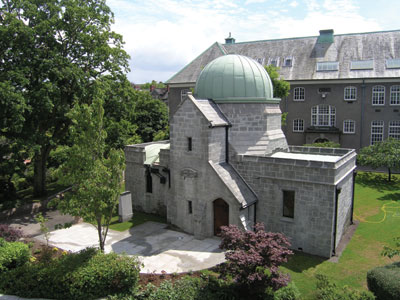|
2006 |
|
YEAR BOOK |
|
2006 |
|
YEAR BOOK |
|
Restoring an astronomical gem |
||||
|
||||

The 126-year old Crawford Observatory located in the heart of the UCC campus has now been fully restored and refurbished. Anna Nolan was at the official opening last June. The Crawford Observatory is the only astronomical observatory situated on an Irish university campus. Originally built in 1880, after many decades, it gradually fell into disuse. It has now been rescued for use thanks to a restoration programme costing €800,000 and will again be used by staff and students for course work and research, and is open to the public. “If students use equipment like this to start off with they can then understand what today’s sophisticated instruments do,” said Dr Paul Callanan, an astronomer and astrophysicist at UCC who was one of the prime movers in getting the refurbishment project going. In its early days the Observatory had been used on a regular basis by university staff, but later on it was only used intermittently and then only sporadically after the 1920s. However, this lack of use over the years has a silver lining for today’s UCC staff and students. “This lack of heavy use was good because it preserved it in a state where we could refurbish it,” said Paul. The Physics Department of UCC has been the custodian of the Observatory down through the years, and made various interventions that kept the place viable. The Observatory is a small building, tiny even, but still manages to contain three highly important telescopes, the Equatorial, the Transit Circle and the Siderostatic. Restoration Extensive restoration works involved conservation of the building itself – including the moving dome and the Meridian room shutter – and the three main telescopes together with an observer’s chair. The need to maintain these historically important telescopes in locations where they are sometimes fully exposed to the weather – the roof is open during observations - was a major challenge for the restoration team. Despite the difficulties, the work was largely faithful to the original design, but some changes were required, such as the replacement of the canvas dome with a copper structure. The restoration team included Howley-Hayes architects, Cornerstone Construction Ltd, the University Archives and Heritage Office, UCC Buildings and Estates Office and the Department of Physics at UCC. Bertie McClure from Belfast, restored many of the old instruments. “The Observatory is a wonderful survival with beautiful 19th century panelling in the interior,” said UCC curator Michael Holland. “It has been sympathetically cleaned and given a new lease of life. Its life span has been expanded by another hundred years.” Funding The original Observatory was built and fitted out in 1879/1880 through the generosity of benefactors, mainly William Crawford, a member of the local brewing family of Beamish and Crawford, and the Duke of Devonshire of Lismore Castle. Alumni of UCC, other friends of the university, as well as some anonymous donors, funded the recent restoration work. As with several other UCC projects, the University Heritage Committee was involved in restoration. An archivist was appointed by the Heritage Committee, and this was followed by the appointment of a curator, Michael Holland. Howard Grubb The Observatory was designed by the famous Sir Howard Grubb, and houses a unique collection of his finest work. Grubb built all the instruments contained in the Observatory, including the telescopes and their associated equipment such as the clocks and the dome. The Grubb family business, which was based in Dublin, along the banks of the Grand Canal, next to the HQ today for the Construction Industry Federation, was Ireland’s foremost maker of scientific instruments. The firm was set up in the 1830s by Thomas Grubb, the father of Howard Grubb, and soon gained an international reputation for excellence. The significance of the Crawford Observatory lies largely in the quality of its instruments, rather than in the findings made by astronomers using the instruments. “No fundamental astronomical discoveries were made in the Crawford Observatory itself,” said Paul Callanan. “Its significance was that it is a perfect example of the work of Grubb, a proving ground and a showcase. It was absolutely leading edge technology of its day. The Siderostatic Telescope, for example, is the ancestor of that used today in Kitt Peak in Arizona and the work done there is still relevant over a hundred years later.” Observatory Nestled inside shrubbery, the Crawford Observatory building is in the same ecclesiastical style as the other early buildings of UCC. The layout was conventional enough for its day, with a two-story central section, and single-story wings. There are four small rooms in the Observatory, three on the ground floor and one upstairs. The visitor enters through the centre room, which is now used to display detailed information about the Observatory. To the left, in a single-story East wing, is the Meridian Room – which is also called the Transit Room – and to the right a room housing the Siderostatic Telescope.
Anna Nolan is one of Ireland’s leading science and technology journalists. This feature appeared originally in Science Spin. |